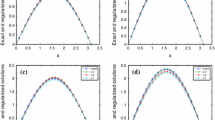Abstract
A new method for the solution of Cauchy problems involving linear elliptic operators is introduced. Starting with an initial guess for the missing boundary condition, the algorithm obtains corrections to the assumed value at every iteration. For the updating part, it uses a sampling function to relate the error field to the unknown boundary condition. It uses the data evaluated at points on the boundary. A filtering technique is also introduced which is tailored to the specific problem at hand. The proposed method requires the Green’s function for the linear operator. A number of systems including Laplace, Helmholtz and biharmonic equations are studied. A number of numerical examples are used to show the applicability of the method in the presence of noise.




















Similar content being viewed by others
Notes
\(\frac{{\partial }\alpha }{{\partial }s}|_i=\frac{1}{12\Delta s} \left( -25\alpha _i+48\alpha _{i+1}-36\alpha _{i+2}+16\alpha _{i+3}-3\alpha _{i+4}\right) \)
References
Andersson LE, Elfving T, Golub GH (1998) Solution of biharmonic equations with application to radar imaging. J Comput Appl Math 94(2):153–180
Ang DD, Gorenflo R, Khoi Le Trong DD (2002) Moment theory and some inverse problems in potential theory and heat conduction. Springer, Germany
Dehghan M (2007) The one-dimensional heat equation subject to a boundary integral specification. Chaos Solitons Fractals 32:661–675
Dehghan M, Najafi M (2016) Numerical solution of a non-classical two-phase Stefan problem via radial basis function (RBF) collocation methods. Eng Anal Bound Elem 72:111–127
Dehghan M, Shafieeabyaneh N, Abbaszadeh M (2021) A local meshless procedure to determine the unknown control parameter in the multi-dimensional inverse problems. Inverse Probl Sci Eng 29(10):1369–1400
Engl HW, Hanke M, Neubauer A (2000) Regularization of inverse problems. Springer, Berlin
Groetsch CW (1993) Inverse problems in mathematical sciences. Springer, Berlin
Hamad A, Tadi M (2019) Inverse scattering based on proper solution space. J Theoret Comput Acoust 27(3):1850033
Han H, Ling L, Takeuchi T (2011) An energy regularization for Cauchy problems of Laplace equation in Annulus domain. Commun Comput Phys 9(4):878–896
Higgins JR (1977) Completeness and basis properties of sets of special functions. Cambridge University Press, Cambridge
Kabanikhin SI (2008) Definitions and examples of inverse and ill-posed problems. J Inverse Ill-Posed Probl 16:317–357
Kirsch A (1996) An introduction to the mathematical theory of inverse problems. Springer, Berlin
Klibanov MV, Santosa F (1991) A computational quazi-resversibility method for Cauchy problems for Laplace’s equation. SIAM J Appl Math 51:1653–1675
Lay D, Lay S, McDonald J (2016) Linear algebra and its applications. Pearson, New York
Leblond J, Mahjoub M, Partington JR (2006) Analytical extensions and Cauchy-type inverse problems on annular domains: stability results. J Inverse Ill-Posed Probl 14(2):189–204
Marin L, Lesnic D (2005) The method of fundamental solutions for inverse boundary value problem associated with two-dimensional biharmonic equation. Math Comput Model 42(3):261–278
Marin L, Elliot L, Heggs PJ, Ingham DB, Lesnic D, Wen X (2004) BEM solution for the Cauchy problem associated with Helmholtz-type equations by Landweber method. Eng Anal Bound Elem 28:1025–1034
Moura Neto FD, Da Silva Neto A.J. (2013) An introduction to inverse problems with applications. Springer, Berlin
Shahmurov R (2010) Solution of the Dirichlet and Neumann problems for a modified Helmholz equation in Bezov spaces on an annulus. J Differ Equ 249:526–550
Stakgold I (1968) Boundary value problems of mathematical physics, vol 2. MxMillan Company, New York
Strauss WT (1992) Partial differential equations. An introduction. Wiley, New York
Tadi M (2017) On elliptic inverse heat conduction problems. ASME J Heat Transf 139(7):074504
Tadi M (2019) A direct method for a Cauchy problem with application to a Tokamak. Theoret Appl Mech Lett 9(4):254–259
Tadi M, Radenkovic M (2021) New computational methods for inverse wave scattering with a new filtering technique. Optim Eng. https://doi.org/10.1007/s11081-021-09638-8
Tadi M, Radenkovic M (2021) Non-iterative solution methods for Cauchy problems for Laplace and Helmholtz equation in annulus domain. Mathematics 9:268
Timoshenko S, Goodier JN (1951) Theory of elasticity. McGraw-Hill, New York
Tran NL, Tran TK, Tra QK (2020) Regularized solution of the Cauchy problem for the biharmonic equation. Bull Malays Math Soc 43:757–782
Wei T, Chen YG, Liu JC (2013) A variational-type method of fundamental solutions for the Cauchy problem of Laplace equation. Appl Math Model 37:1039–1053
Xue-Hong W, Wen-Quan T (2008) Meshless method based on the local weak-forms for steady-state heat conduction problems. Int J Heat Mass Transf 51:3103–3112
Funding
There are no funding to report on this work.
Author information
Authors and Affiliations
Corresponding author
Ethics declarations
Conflict of interest
None.
Code availibility
All codes will be provided upon request.
Additional information
Publisher's Note
Springer Nature remains neutral with regard to jurisdictional claims in published maps and institutional affiliations.
Rights and permissions
Springer Nature or its licensor (e.g. a society or other partner) holds exclusive rights to this article under a publishing agreement with the author(s) or other rightsholder(s); author self-archiving of the accepted manuscript version of this article is solely governed by the terms of such publishing agreement and applicable law.
About this article
Cite this article
Tadi, M., Radenkovic, M. A unified solution method for linear elliptic Cauchy problems. Comp. Appl. Math. 42, 113 (2023). https://doi.org/10.1007/s40314-023-02267-0
Received:
Revised:
Accepted:
Published:
DOI: https://doi.org/10.1007/s40314-023-02267-0



